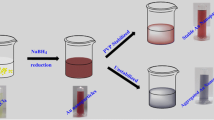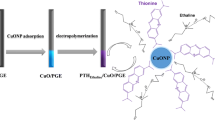Abstract
A film consisting of poly(γ-glutamic acid) modified with 3-aminothiophene (ATh-γ-PGA) was prepared by macromolecular self-assembly and electropolymerization. ATh-γ-PGA is amphiphilic and electrically conductive. The copolymers undergo self-assembly to form nanoparticles (NPs) on decreasing the pH value of an aqueous solution. A conducting film of NPs was formed on the surface of a gold electrode by casting the ATh-γ-PGA NPs and subsequently electropolymerizing the thiophene units. Next, horseradish peroxidase and Nafion were cast onto the film to obtain an enzymatic biosensor for H2O2. Due to the electropolymerization step, a cross-conjugated polymer network is created that improves electron transfer rates and thus enhances the response. This endows the biosensor with high sensitivity. Two linear ranges are present, the first ranging from 1 × 10−11 to 1 × 10−8 mol·L−1, and the second from 1 × 10−8 to 1 × 10−5 mol·L−1. The detection limit is as low as 3 × 10−12 mol·L−1. The sensor is stable, repeatable, and was successfully applied to the determination of H2O2 in a commercial disinfecting solution.

Preparation of a conducting nanoparticle (NP) film on the gold electrode (GE) by self-assembly of poly(γ-glutamic acid) that was modified with electroactive 3-aminothiophene (ATh-γ-PGA). It served as a platform for the fabricationof an ultrasensitive voltammetric enzyme-based biosensor for H2O2.






Similar content being viewed by others
References
Chen W, Cai S, Ren QQ, Wen W, Zhao YD (2012) Recent advances in electrochemical sensing for hydrogen peroxide: a review. Analyst 137:49–58
Liu Q, Lu XB, Li J, Yao X, Li JH (2007) Direct electrochemistry of glucose oxidase and electrochemical biosensing of glucose on quantum dots/carbon nanotubes electrodes. Biosens Bioelectron 22:3203–3209
Li J, Lin XQ (2007) Glucose biosensor based on immobilization of glucose oxidase in poly(o-aminophenol) film on polypyrrole-Pt nanocomposite modified glassy carbon electrode. Biosens Bioelectron 22:2898–2905
Xu Q, Zhu JJ, Hu XY (2007) Ordered mesoporous polyaniline film as a new matrix for enzyme immobilization and biosensor construction. Anal Chim Acta 597:151–156
Wang L, Wang EK (2004) A novel hydrogen peroxide sensor based on horseradish peroxidase immobilized on colloidal Au modified ITO electrode. Electrochem Commun 6:225–229
Miao Y, Wen Y, Dong J, Zhou WX, Zhang ZR, Yang HF (2011) Botanical micelle and its application for direct electrochemical biosensor. Biosens Bioelectron 26:2994–2999
Gorton L, Lindgren A, Larsson T, Munteanu FD, Ruzgas T, Gazaryan I (1999) Direct electron transfer between heme-containing enzymes and electrodes as basis for third generation biosensors. Anal Chim Acta 400:91–108
Jia JB, Wang BQ, AG W, Cheng GJ, Li Z, Dong SJ (2002) A method to construct a third-generation horseradish peroxidase biosensor: self-assembling gold nanoparticles to three-dimensional sol-gel network. Anal Chem 74:2217–2223
Mukhopadhyay P, Mishra R, Rana D, Kundu PP (2012) Strategies for effective oral insulin delivery with modified chitosan nanoparticles: a review. Prog Polym Sci 37:1457–1475
Yang YQ, Luo J, Liu R, Liu JK, Jiang JQ, Liu XY (2011) Glucose sensors based on electrodeposition of molecularly imprinted polymeric micelles: a novel strategy for MIP sensors. Biosens Bioelectron 26:2607–2612
Luo J, Fan CH, Wang XH, Liu R, Liu XY (2013) A novel electrochemical sensor for paracetamol based on molecularly imprinted polymeric micelles. Sensors Actuators B Chem 188:909–916
Zhang RL, Xu S, Luo J, Shi DJ, Liu C, Liu XY (2014) One-pot green synthesis of nanohybrid structures: gold nanoparticles in poly(γ-glutamic acid) copolymer nanoparticles. RSC Adv 4:25106–25113
Zhang RL, Xu S, Zhu Y, Zhao W, Luo J, Liu XY, Tang DX (2016) Molecularly imprinted nanohybrids based on dopamine-modified poly(γ-glutamic acid) for electrochemical sensing of melamine. Biosens Bioelectron 85:381–386
Zhang RL, Xu S, Luo J, Liu XY (2015) Molecularly imprinted photo-sensitive polyglutamic acid nanoparticles for electrochemical sensing of hemoglobin. Microchim Acta 182:175–183
Zhang RL, Sun JD, Luo J, Xu S, Liu XY (2014) Preparation of photo-sensitive poly(γ-glutamic acid) nanoparticles and application for immobilizing hemoglobin on electrode. Colloid Polym Sci 292:2295–2302
Ates M (2013) A review study of (bio)sensor systems based on conducting polymers. Mater Sci Eng C 33:1853–1859
Aguilar-Ortíz E, Zaragoza-Galán G, Solladié N, Rein R, Aguilar-Martínez M, Macías-Ruvalcaba N, Rivera E (2012) Preparation and characterization of novel polythiophenes bearing oligo(ethylene glycol) spacers and porphyrin units: optical and electrochemical properties. Synth Met 2162:1000–1009
Nien PC, Chen PY, Ho KC (2009) Fabricating an amperometric cholesterol biosensor by a vovalent linkage between poly(3-thiopheneacetic acid) and cholesterol oxidase. Sensors 9:1794–1806
Xu J, Bai HY, Yi CL, Luo J, Yang C, Xia WS, Liu XY (2011) Self-assembly behavior between native hyaluronan and styrylpyridinium in aqueous solution. Carbohydr Polym 86:678–683
Luo J, Ma Q, Wei W, Zhu Y, Liu R, Liu XY (2016) Synthesis of water-dispersible molecularly imprinted electroactive nanoparticles for the sensitive and selective paracetamol detection. ACS Appl Mater Interfaces 8:21028–21038
Krikstolaityte V, Kuliesius J, Ramanaviciene A, Mikoliunaite L, Kausaite-Minkstimiene A, Oztekin Y, Ramanavicius A (2014) Enzymatic polymerization of polythiophene by immobilized glucose oxidase. Polymer 55:1613–1620
Pal RK, Farghaly AA, Wang CZ, Collinson MM, Kundu SC, Yadavalli VK (2016) Conducting polymer-silk biocomposites for flexible and biodegradable electrochemical sensors. Biosens Bioelectron 81:294–302
Lei W, Si WM, Xu YJ, Gu ZY, Hao QL (2014) Conducting polymer composites with graphene for use in chemical sensors and biosensors. Microchim Acta 181:707–722
Zhang HQ, Hu LW, Tu JG, Jiao SQ (2014) Electrochemically assembling of polythiophene film in ionic liquids (ILs) microemulsions and its application in an electrochemical capacitor. Electrochim Acta 120:122–127
Pang YH, Li XY, Ding HL, Shi GY, Jin LT (2007) Electropolymerization of high quality electrochromic poly(3-alkyl-thiophene)s via a room temperature ionic liquid. Electrochim Acta 52:6172–6177
Fei XM, Luo J, Liu R, Liu JC, Liu XY, Chen MQ (2015) Multiwalled carbon nanotubes noncovalently functionalized by electro-active amphiphilic copolymer micelles for selective dopamine detection. RSC Adv 5:18233–18241
Prodromidis MI (2010) Impedimetric immunosensors-a review. Electrochim Acta 55:4227–4233
Dong Y, Wang L, Nie F, Zheng JB (2016) Hydrogen peroxide biosensor based on polypyrrole-pullerene-DDAB nanocomposite film. Sens Lett 14:656–664
Sun MJ, Song GQ, Liu JJ, Chen HM, Nie FQ (2017) In situ controllable synthesis of cotton-like polyaniline nanostructures for a H2O2 sensor using an embedded three-electrode microfluidic chip. RSC Adv 22:13637–13642
Lyon JL, Stevenson KJ (2006) Picomolar peroxide detection using a chemically activated redox mediator and square wave voltammetry. Anal Chem 78:8518–8525
Salimi A, Miranzadeh L, Hallaj R, Mamkhezri H (2008) Picomolar detection of hydrogen peroxide at glassy carbon electrode modified with NAD+ and single walled carbon nanotubes. Electroanalysis 20:1760–1768
Wang N, Sun JC, Chen LJ, Fan H, Ai SY (2015) A Cu2(OH)3Cl-CeO2 nanocomposite with peroxidase-like activity, and its application to the determination of hydrogen peroxide, glucose and cholesterol. Microchim Acta 182:1733–1738
Ngamaroonchote A, Chotsuwan C, Tantisantisom K, Laocharoensuk R (2017) Patterned gold electrode prepared from optical discs display largely enhanced electrochemical sensitivity as exemplified in a sensor for hydrogen peroxide. Microchim Acta 184:211–218
Wang JJ, Wang Y, Cui M, Xu SH, Luo XL (2017) Enzymeless voltammetric hydrogen peroxide sensor based on the use of PEDOT doped with Prussian blue nanoparticles. Microchim Acta 184:483–489
Lata S, Batra B, Karwasra N, Pundir CS (2012) An amperometric H2O2 biosensor based on cytochrome c immobilized onto nickel oxide nanoparticles/carboxylated multiwalled carbon nanotubes/polyaniline modified gold electrode. Process Biochem 47:992–998
Acknowledgements
This work was supported by the National Natural Science Foundation of China (NSFC 21504001, 51572004), the foundation of Key Laboratory of Food Colloids and Biotechnology, Ministry of Education, Jiangnan University (JDSJ2015-02), Natural Science Foundation of the Higher Education Institutions of Anhui Province (KJ2016SD06, KJ2017A115) and the Anhui Provincial Natural Science Research Program of High Education Improvement Plan (TSKJ2016B17).
Author information
Authors and Affiliations
Corresponding authors
Ethics declarations
The author(s) declare that they have no competing interests.
Electronic supplementary material
ESM 1
(DOCX 1.54 MB)
Rights and permissions
About this article
Cite this article
Zhang, R., Jiang, C., Fan, X. et al. A gold electrode modified with a nanoparticulate film composed of a conducting copolymer for ultrasensitive voltammetric sensing of hydrogen peroxide. Microchim Acta 185, 58 (2018). https://doi.org/10.1007/s00604-017-2564-x
Received:
Accepted:
Published:
DOI: https://doi.org/10.1007/s00604-017-2564-x




